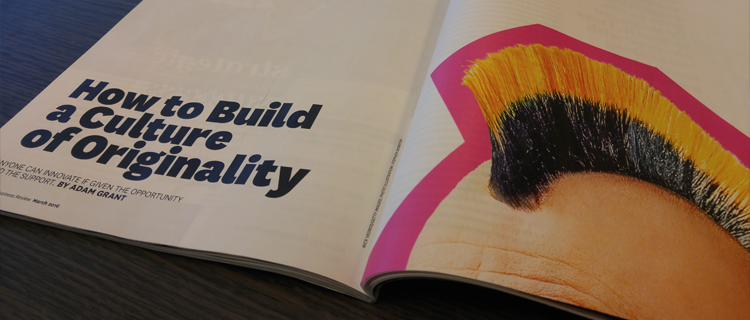In what I hope to be a recurring blog entry category I will comment on and/or highlight aspects of readings that I have found to contain meaningful insight on subjects that pertain to my professional ambitions and experiences. In doing so I hope to extract additional value from readings that may too quickly slip from memory after only one read through.
One publication I subscribe to and will likely be a frequent source of my commentary is the Harvard Business Review. I’ve been a subscriber for 4 years now and I’ve always found the topics of discussion to be varied, fresh and inciteful. I jokingly refer to it as my unofficial MBA and given the span of topics 4 years of issues have covered I owe to it a great insight in the broad spectrum of areas that comprise a modern successful business.
The article I am commenting on today is one by Adam Grant titled How to Build a Culture of Originality. In it the author reflects on his studies of a greater part of a decade on how to foster an organizational culture that brings about innovation and change. In some cases he challenges some preconceived notions of where and how to bring about innovation, notions that in some cases serve to detract from individuals of the organization’s capability to be innovative. Going so far as to say that “Most people are in fact quite capable of novel thinking and problem solving, if only their organization would stop pounding them into conformity.”
I feel the author emphasizes organizational behaviors that reflect my personal expectation and want from an organization’s culture. It also served to highlight problematic behaviours I have experienced in organizations that I felt stifled and impeded any novelty and innovation from being bred within the company walls; behaviours that I ascribe to being the source to my feelings of creeping employment dissatisfaction which have inevitably led me to move on from employers.
One of the more vital behaviours as required of a culture of originality is what the author calls cultivating both cohesion and dissent. The two behaviours seemingly at odds with one another are not mutually exclusive but mutually beneficial. Cohesion ensures there is comfort in communicating with one another on diverse and divergent viewpoints; members of the group are secure enough to not misconstrue dissent as a challenge on the company or group’s core values. Dissent ensures that cohesion doesn’t allow a strong culture to become homogeneous and insular to the point that there is too much comfort and unchanging perspective within the ranks of the organization. A quality that risks responding to shifting industry conditions in a way that is too biased to the current way of doing things.
To insure earnest dissent, the author suggests to not only go as far as to ask employees play devil’s advocate but to actually find individuals that hold opposing opinions. He highlights research by UC Berkley psychologist Charlan Nemeth that shows playing devil’s advocate doesn’t overcome confirmation bias. Holding a dissenting view rather than expressing one for arguments sake will ensure a disagreement is forcefully argued and taken seriously.
Inevitably amongst conflicting opinions a course of action needs to be taken. To decide on the best of competing courses the author suggests organizational values need to be rank-ordered. When weighing the strengths and weaknesses of an action, added weight can be given to strengths that align with the companies highest priority values.
This is not to argue for some complex hierarchy of several values to weigh every choice against. The author argues that no more than four values should be established within any organization, in doing so decisions are guided by only the most important and well defined of values.
In closing the article the author reiterates the need to enforce a culture that promotes and rewards the contribution of ideas and remove any fear of offering dissenting view points. Recognize and reward individuals whose ideas have contributed to the success of the organization and applaud employees for speaking up even if their ideas don’t get adopted. Promote a challenge to the status quo and you eliminate conformity, listen to a wider range of insights and you will inspire greater original thinking.
